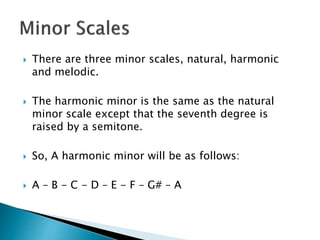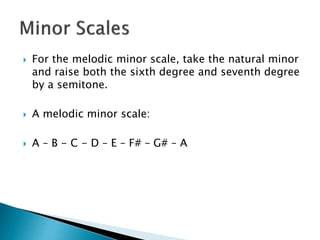Basic music theory 2
- 1. Lesson 2: Constructing Key signatures Cylent Beatz Production
- 2. ï― A semitone or half step is the movement of sharpening or flattening a note. C > C# C > Cb ï― A tone or whole step consists of two semitone steps. C C > D C > B
- 3. ï― Key signatures are constructed using a series of tones and semitones. ï― The order of which are determined by the quality of the scale. For example, whether it is major or minor. ï― A keyboard can help in working out the steps.
- 4. ï― The order of these steps for the major scale are: ï― T, T, S, T, T, T, S T = Tone S = Semitone ï― Using that formula to construct A major: ï― A â B - C# - D â E - F# - G# - A
- 5. ï― The order of these steps for the natural minor scale are: ï― T, S, T, T, S, T, T T = Tone S = Semitone ï― Using that formula to construct A minor: ï― A â B - C - D â E - F - G â A ï― There exist other minor scales.
- 6. ï― There are three minor scales, natural, harmonic and melodic. ï― The harmonic minor is the same as the natural minor scale except that the seventh degree is raised by a semitone. ï― So, A harmonic minor will be as follows: ï― A â B - C - D â E - F â G# â A
- 7. ï― For the melodic minor scale, take the natural minor and raise both the sixth degree and seventh degree by a semitone. ï― A melodic minor scale: ï― A â B - C - D â E â F# â G# â A







